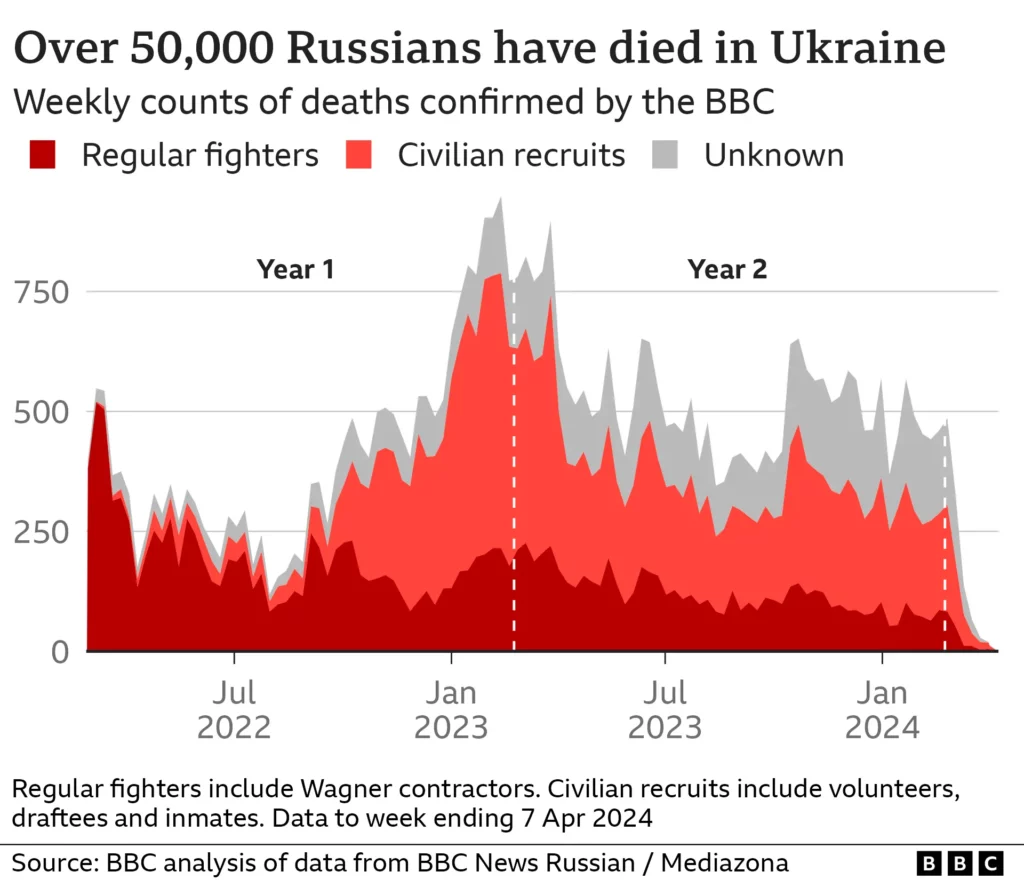The can confirm that Russia’s military casualties in Ukraine have already topped fifty thousand.
We discovered that the number of dead on the front lines was about 25% greater in the second year than the first, as Moscow pressed its so-called meat grinder tactic.
Since February 2022, the independent media organization Mediazona, volunteers, and the Russian have been compiling a death toll.
Several soldiers’ names were made available via recently dug graves in cemeteries.
Additionally, our teams searched through publicly available data from newspapers, social media, and government sources.
Our findings show that almost 27,300 Russian soldiers lost their lives in the second year of conflict, illustrating the high human cost associated with territorial gains.
Russia has refrained from providing a statement.
The way Moscow constantly pushes waves of soldiers forward in an attempt to wear down Ukrainian forces and reveal their locations to Russian artillery has been dubbed a “meat grinder.”
Over 50,000 people have died overall, which is eight times more than the number of fatalities that Moscow has ever officially acknowledged in public, which was released in September 2022.
It’s likely that even more Russians have died in reality.
The militia killings in eastern Ukraine’s Russian-occupied Donetsk and Luhansk are not included in our study. The number of Russian deaths would have increased if they had been included.
Conversely, Ukraine hardly ever discusses the number of its soldiers that have died in combat. President Volodymyr Zelensky claimed in February that 31,000 Ukrainian soldiers had died; however, figures derived from US intelligence point to higher casualties.

Strategies for meat grinders
The most recent list of dead soldiers released by Mediazona and the demonstrates the terrible human cost of Russia’s shifting front-line tactics.
The graph below illustrates how the Russian military’s death toll skyrocketed in January 2023 when it launched a major operation in the Ukrainian Donetsk region.
The Institute for the Study of War (ISW) claims that “ineffective human-wave style frontal assaults” were employed by the Russians un their battle for the city of Vuhledar.
It claimed that there were few victories and significant combat casualties as a result of “tough terrain, a lack of combat power, and failure to surprise Ukrainian forces.”
When Wagner, a mercenary organization, assisted Russia in capturing Bakhmut in the spring of 2023, there was another notable jump in the graph.
Yevgeny Prigozhin, the leader of Wagner’s group, calculated that his group had lost 22,000 at that point.
Another spike in military fatalities followed Russia’s takeover of the eastern Ukrainian city of Avdiivka last October.
Keeping track of graves
Since the beginning of the conflict, volunteers with counting the number of new military burials in 70 cemeteries throughout Russia.
Aerial photographs reveal a considerable expansion of graveyards.
For instance, these pictures of Ryazan’s Bogorodskoye Cemetery, which is southeast of Moscow, demonstrate the appearance of a whole new part.
The majority of these new burials appear to be those of soldiers and officers who died in Ukraine, based on images and films shot on the ground.
Read More: Putin gifts North Korea’s Kim Jong Un Russian-made car!
‘Be ready to die’
Prisoners were usually hired by Wagner for a period of six months. At the conclusion, the fighters would receive their freedom, should they made it out alive.
However, starting last September, enlisted inmates have been required to fight under the ministry of defense until the end of the war, whichever comes first.
The reports lately of inmates pleading with family members for assistance in purchasing appropriate boots and clothing. Additionally, there have been stories of prisoners being sent to battle without the necessary equipment, medical supplies, or even Kalashnikov rifles.

Based in Russian-occupied eastern Ukraine, Grubnik asserts that commanders declared it “impossible” for some firearms to be replaced when they discovered they were “completely broken.”
“The rifle had been assigned to the person, and the harsh military bureaucracy couldn’t do anything about it.”
Former inmates have also spoken of the heavy price their friends suffered.
Sergei warns, “If you sign up now, be ready to die, mate,” on a shared information web forum for Storm combatants and their families.
He says he’s been fighting in a Storm squad since October and was once a prisoner.
Out of the 100 men in a Storm platoon five months ago, only 38 are still alive, according to another forum user.
“Every combat mission is like being born again.”
Direct input By: BBC NEWS








